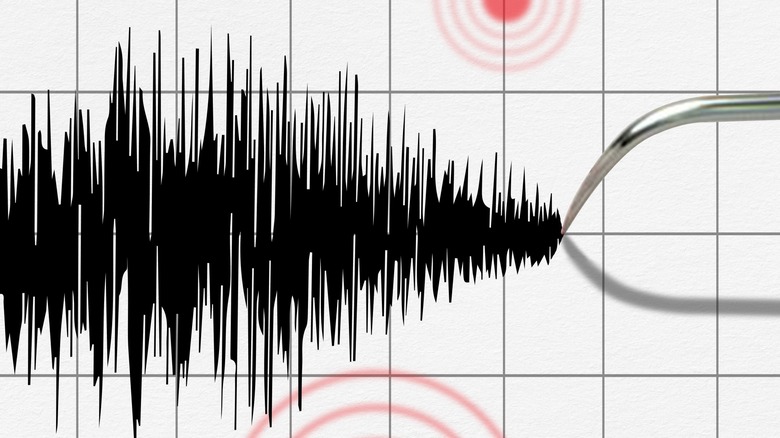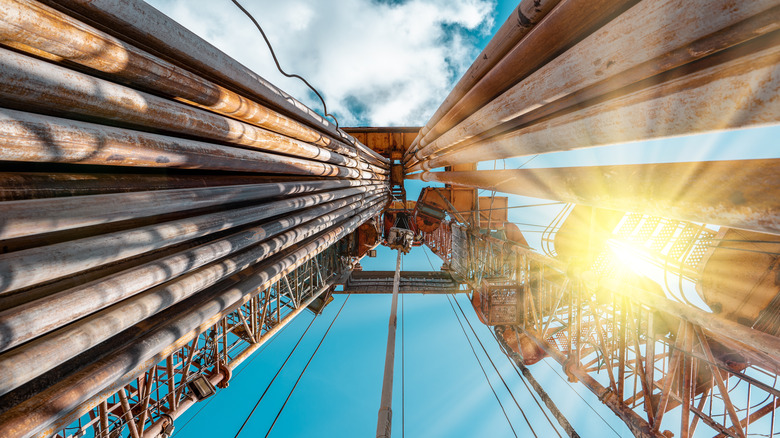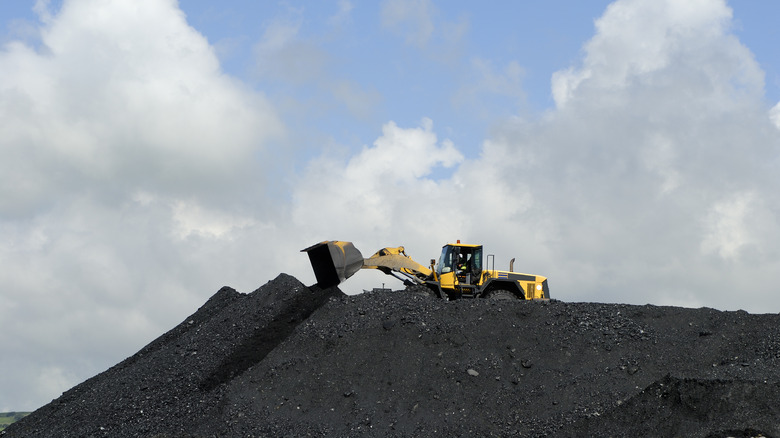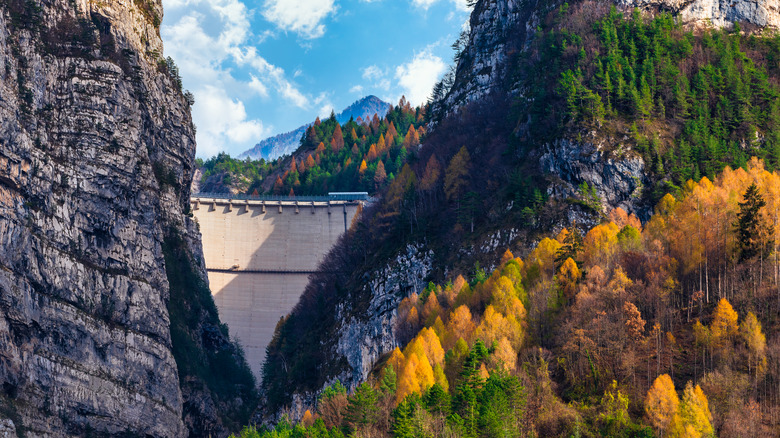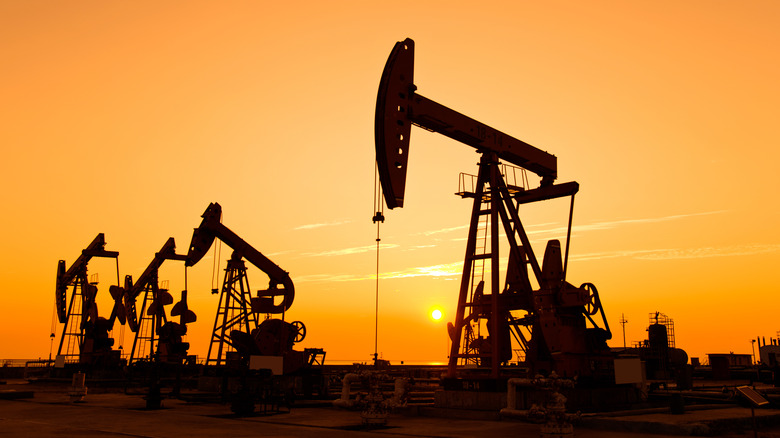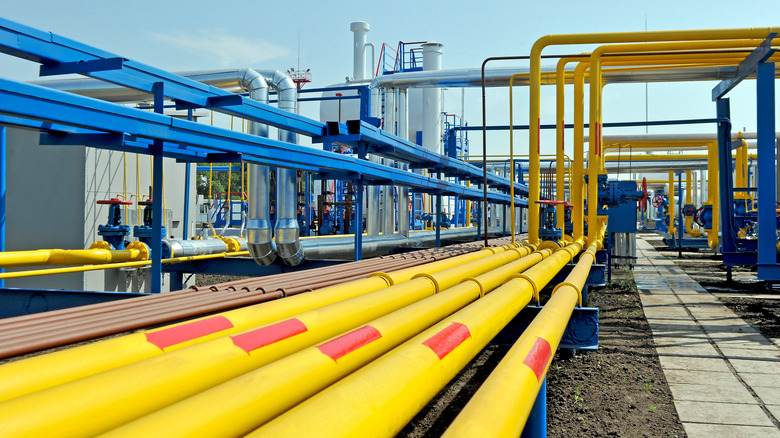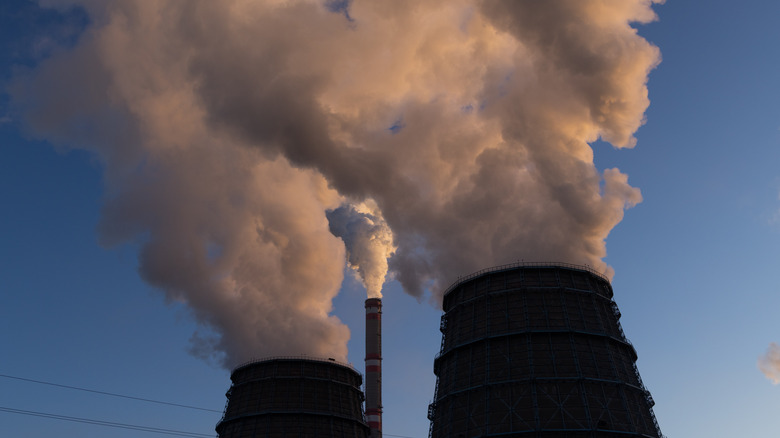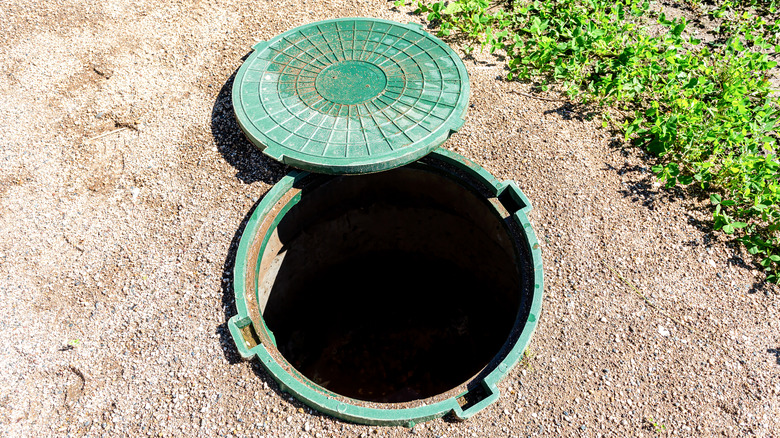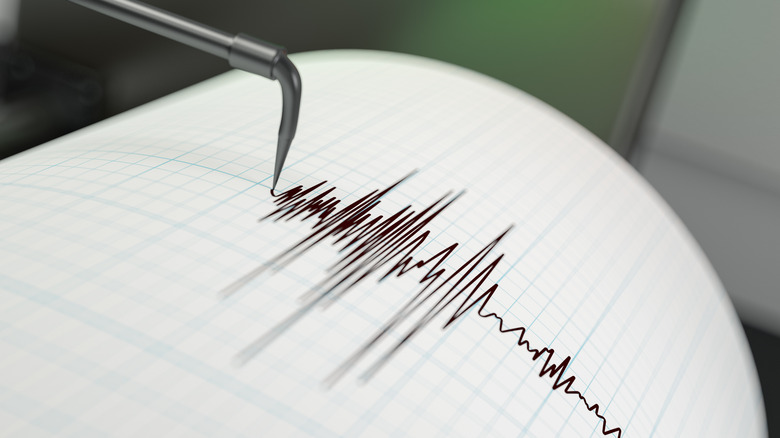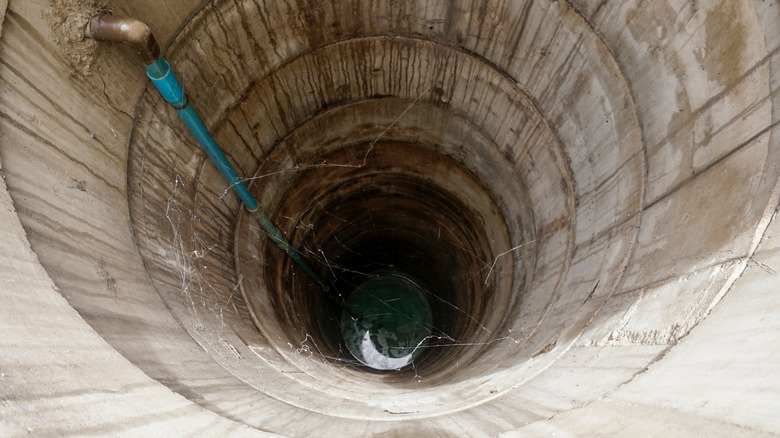How Earthquakes Can Be Triggered By People
Earthquakes are typically thought to be an utterly uncontrollable natural disaster. Seemingly, there's no way that humans could have any control over the massive tectonic plates beneath their feet, so the only thing to do in terms of earthquake prevention is focus on being prepared and having solid infrastructure. But in fact, many earthquakes in recent history have been induced by human activity.
The impact of human-induced earthquakes has been so strong that in the United States, Oklahoma City is at a higher risk of seismic activity than California. And human-induced earthquakes aren't always accidental. Weapons like the earthquake bomb are specifically designed to send shockwaves similar to those set off by an earthquake. Meanwhile, tectonic weapons have also been theorized as a way to trigger earthquakes as a means of warfare. And while some induced seismic activity has decreased as mining activity has decreased, an increase in fracking has been found to be directly correlated with a rise in seismic activity.
But the devastation wrought by earthquakes is not entirely uncontrollable, regardless of whether or not they're induced accidentally or on purpose. Ultimately, most people can agree that less earthquakes is always the best number of earthquakes. These are some of the ways earthquakes can be triggered by people.
Fracking
Currently, one of the most common ways that humans can cause earthquakes is by fracking, also known as hydraulic fracturing. Fracking involves injecting a fluid mixture into the earth to create cracks, permitting the movement and subsequent extraction of oil and natural gas. The water injected into the rock layers also ends up coming back up with the oil and natural gas. When it rises back up, it gets separated and pumped back down into disposal wells, soaking into the rock along the way. This can cause a change in pressure that may upset a fault and set off an earthquake. In Oklahoma alone, four of the five largest earthquakes ever experienced by the state were induced by fracking-related human activity, and 2% of all their earthquakes are related to fracking.
Although the U.S. Geological Society claims that fracking itself doesn't cause earthquakes, they acknowledge that "the recent increase in earthquakes in the central United States is primarily caused by disposal of waste fluids that are a byproduct of oil production." But some scientists believe that fluid disposal isn't the only part of fracking that causes earthquakes. According to a 2016 study published in Science, researchers in Canada have linked the act of fracking itself to earthquakes in Alberta, Canada, as well. Meanwhile, The Human-Induced Earthquake Database has recorded over 400 earthquakes worldwide believed to have been induced by fracking or fracking-related activity.
Mining
Mining projects are another frequent cause of human-induced earthquakes. This tends to occur because when large amounts of rock and earth are moved during mining, this causes stress changes in the surrounding rock mass along with the creation of faults and fracture planes. Roughly 37% of all human-induced earthquakes are caused by mining activity, with coal mining being the largest culprit. In places like the United Kingdom, as coal production has decreased, so has the number of human-induced earthquakes, according to Marine and Petroleum Geology.
In Newcastle, New South Wales, Australia, the emergence of a mining industry in 1801 resulted in an increase of seismic activity in the region throughout the 19th and 20th centuries. In 2014, the largest mining-related earthquake in South Africa was recorded with a magnitude of 5.5 and stemmed from a gold-mining area– one 31-year-old man died as a result. And in Germany, salt mining has resulted in earthquakes with magnitudes as high as 5.6. Sometimes, mining can even cause thousands of small earthquakes throughout the year, as is the case in the Legnica-Glógow Copper District in Polkowice County, Poland, writes Frontiers in Earth Science. Generally, tunnel collapses during mining are most often responsible for induced earthquakes.
And the act of mining itself isn't the only thing that can cause an earthquake. On August 6, 2007, a coal mine collapse in the Crandall Canyon Mine in Utah, United States, triggered a magnitude 3.9 earthquake.
Reservoir impoundment
The creation of water reservoirs has also been linked to human-induced seismic activity. One of the biggest examples of this is the 1967 Koynanagar earthquake in Maharashtra, India. With magnitudes measured between 6.3 and 7.5, this earthquake was caused by the vastly increased water weight on the earth after the dam was filled in 1963. Additionally, there aren't any sites with a history of seismic activity near the Koyna Dam. The earthquake was the strongest one ever experienced by the region and resulted in almost 200 deaths, while displacing thousands more. And it's estimated that up to five of the nine strongest earthquakes ever recorded on the Indian peninsula were caused by dam-related human activity.
The knowledge that dams can cause earthquakes isn't new and was first reported in 1932. Since then, between 70 and 230 earthquakes have been recorded that were caused by water reservoir impoundment. One of the deadliest dam disasters in history is also due to earthquakes caused by reservoir impoundment. As soon as construction started on the Vajont Dam in Erto e Casso, Italy, under Monte Toc, there were tremors and landslides. But all the warnings about potential earthquakes were ignored even while tremors continued, as the dam was filled in 1960. The tremors continued, and in 1963, the tremors triggered a landslide that caused a flood of over 13 billion gallons of water into the Piave Valley. Roughly 2,000 people died in the flood, and several villages were completely destroyed.
Oil drilling
Fracking isn't the only kind of oil and natural gas extraction method that causes earthquakes. Even conventional oil drilling and natural gas extraction has been known to cause earthquakes for years. The rise in seismic activity in Los Angeles, California, between the 1920s and 1940s is even attributed to oil drilling in the area, although it's believed that rather than directly causing the earthquakes, oil drilling made them happen sooner than they necessarily would have. The 1933 Long Beach earthquake is one of many earthquakes at this time associated with oil drilling.
Waterflooding, a technique used in oil production that involves injecting water into a reservoir, has also been shown to cause earthquakes. After an oil field in Snyder, Texas, was waterflooded between 1957 and 1982, a series of earthquakes were recorded up through 1982. A 2013 study published in PNAS also suggested that carbon dioxide injection, which is also used in oil production, may have contributed to the rise in seismic activity in Texas.
Some oil wells operate in and make wastewater injections into shallower levels of rock in an attempt to decrease the chance of earthquakes. But according to Science, this actually causes more frequent and stronger earthquakes than deeper injections. Shallow injections have been found to cause earthquakes with magnitudes up to 4.7, while deeper wastewater injections caused smaller earthquakes at magnitude 2.0.
Natural gas extraction
Natural gas extraction can be responsible for increases in seismic activity. In Groningen, Netherlands, between 1999 and 2014, there was an increase in both the frequency and the severity of earthquakes, with magnitudes growing from 1.5 to 3.6, per Risk Analysis. In June 2023, the Dutch government decided to cease operations at Groningen field, one of the largest natural gas fields in the world, by October 2023, due to increased seismic activity caused by the natural gas extraction.
From 1976 to 1984, Gazli, Uzbekistan, also experienced three magnitude 7.0 earthquakes in a region that had once been largely aseismic. These three earthquakes are all attributed to the activities of the Gazli gas field.
In the United States, Colorado has also seen increased seismic activity due to nearby natural gas production. In western Las Animas County, there have been 12 recorded earthquakes between 2001 and 2013. Although there were no injuries caused by the natural gas extraction-induced earthquakes in the Colorado region, the earthquakes have caused hundreds of thousands of dollars in damages. And according to the Vrije Universiteit Amsterdam, one of the biggest dangers of earthquakes induced by natural gas extraction is the fact that subsequent earthquakes may come years, if not decades, later.
Carbon capture and storage
Over the past few decades, carbon capture and storage (CCS) have become a popular method to try to bypass carbon emissions. But one method of CCS — pumping fluid carbon dioxide underground into porous rocks — has been found to cause earthquakes up to magnitude 3 or more. Some of the 100 earthquakes in West Texas between 2009 and 2010 were found to be caused by CCS, and it has been suggested that CCS caused the 2018 Hokkaido Eastern Iburi earthquake in Japan, but this is debated among researchers.
Unfortunately, there is little consistency with which CCS causes earthquakes, and it's been found to happen in some places more than others. And because earthquakes of any size can cause the carbon dioxide to be released, more viable methods of CCS might need to be considered. But according to MIT Climate Portal, it's possible to mitigate the risk of earthquakes associated with CCS by only injecting carbon dioxide into soft sedimentary rock that isn't near a fault line. In 2013, Yale researchers also suggested that storing carbon dioxide in chemically reactive mafic rock could help avoid causing earthquakes.
Geothermal energy
Geothermal plants are another cause of human-induced earthquakes around the world. The most destructive earthquake in South Korea's history, the 2017 Pohang earthquake, is just one of many caused by human geothermal activity. The Pohang earthquake, which occurred in the North Gyeongsang Province, was caused by a nearby experimental geothermal power plant that was trying to boil water underground using high-pressure injection. Due to the damage caused by the earthquake, over 1,000 people were displaced.
The 2006 Basel earthquake in Switzerland was also caused by drilling and pressuring water pumping for a geothermal project in Kleinhüningen, known as the Swiss Deep Heat Mining Project. The 2006 earthquake was the strongest, with a magnitude of 3.4, but there were several more smaller quakes associated with the geothermal project. Geopower Basel, which was responsible for the project, ended up paying over $10 million for damages caused by the earthquake. And even after the project was canceled, thousands of smaller earthquakes were registered in the region.
Despite the potential benefits of geothermal energy, director of the Swiss Seismological Service in Zurich, Domenico Giardini, maintains that the technology should not yet be used in places that already have a history of seismic activity, according to LiveScience.
Wastewater disposal
In 1961, the United States Army started disposing of toxic wastewater from napalm production by injecting it into a well drilled into the Rocky Mountains. The wastewater came from a chemical weapons manufacturing plant near Denver, Colorado, known as the Rocky Mountain Arsenal and over the course of five years, up to 165 million gallons of wastewater was injected into the Rocky Mountains.
During this time, over 1,500 earthquakes were recorded in the region, with a drastic increase in frequency, and almost all of the earthquakes occurred within 5 miles of the well where the toxic wastewater was being injected. The strongest earthquake recorded had a magnitude of 5.3 and occurred a year after wastewater injections ceased.
Due to the fact that this wastewater disposal was causing earthquakes, the Army abandoned the well in February 1966, and permanently sealed it in 1985. But despite abandoning the well, earthquakes continued in the region until 1981. And according to a bulletin from the U.S. Geological Survey, the fact that the strongest earthquake occurred after use of the well was abandoned demonstrates how uncontrollable earthquakes caused by wastewater injections may be.
Seismic research
Not all induced seismicity is accidental. In 1969, American researchers from the United States Geological Society experimented with inducing earthquakes through fluid pressure. Although geologists knew that fluid pressure could set off earthquakes, they still weren't sure exactly how much pressure was necessary to induce the smallest earthquake.
Using Chevron Oil wells in Rangely, Colorado, scientists injected fluid at fluctuating rates and monitored the seismic activity caused by the pressure. In one of the experiments in November 1972, once water was pumped into the wells, it set off a series of minor earthquakes that continued until the water was pumped out in March 1973.
Although most of the earthquakes caused during this time were relatively small, the largest one was measured at a magnitude of 3.1. According to researcher John Shaw (via the Seismological Society of America), these experiments demonstrated how "even small perturbations in the subsurface caused by human activities can actually destabilize faults that have the right orientations and the right properties."
Groundwater extraction
In September 2015, the Sea of Galilee experienced a series of earthquakes that lasted four days, caused by Israelis pumping fresh water from underground aquifers. Another series of over a dozen earthquakes in July 2018 was also attributed to groundwater extraction. North of Delhi, India, a region known as the Aravalli-Delhi Fold Belt has also seen an increase in seismic activity caused by groundwater pumping.
In 2011, the region of Murcia experienced one of its worst earthquakes in over half a century near Lorca, Spain, when a magnitude 5.1 earthquake caused the deaths of nine people. The earthquake was caused by slippage near a water basin, and groundwater extraction was responsible for the extensive damage that the earthquake caused.
It's been suggested that groundwater extraction in California may also be affecting the San Andreas Fault. The pumping of groundwater in California is largely for irrigation purposes and has been depleting the groundwater since the mid-1800s. The amount of small earthquakes especially has increased as a result, with the amount doubling every year between 1984 and 2005. While the San Andreas fault will always be a center for seismic activity, groundwater extraction may be stressing the fault more often than ever.
